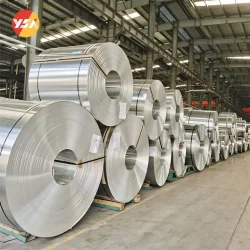Boiling Point of Aluminum
The boiling point of aluminum is approximately 2,519°C or 4,566°F. Aluminum has a relatively low boiling point compared to many other metals. The boiling point can vary depending on factors such as alloy composition, impurities, and other variables.
The Boiling Points of Other Metals (°C)

- Iron (Fe): Approximately 2,862°C
- Copper (Cu): Approximately 2,562°C
- Silver (Ag): Approximately 2,162°C
- Zinc (Zn): Approximately 907°C
- Nickel (Ni): Approximately 2,670°C
- Titanium (Ti): Approximately 3,034°C
- Chromium (Cr): Approximately 2,676°C
- Tungsten (W): Approximately 5,555°C
- Steel (an iron alloy): Typically above 2,500°C
- Tin (Sn): Approximately 2,270°C
Aluminum Foil (Al) VS Tin Foil (Sn)
While aluminum and tin share some similarities as metals, such as relatively low melting points, they have distinct properties and applications.
Aluminum is known for its lightweight, high strength, and excellent corrosion resistance, making it suitable for a wide range of industrial uses. Tin, on the other hand, is softer, has a lower strength, and is often used as a coating or alloyed with other metals to enhance their properties.
- Physical Properties:
- The density of tin is around 7.3 g/cm³ , aluminum is about 2.7 g/cm³. Aluminum is a lightweight metal with a low density, while tin is denser and heavier.
- Aluminum has a higher melting point and boiling point compared to tin.
- Strength and Hardness:
- Aluminum has relatively high strength and hardness.
- Tin is relatively soft and has lower strength and hardness compared to aluminum.
- Thermal conductivity:
- Tin paper has poor thermal conductivity, not easy to conduct heat.
- Aluminum foil is better in thermal conductivity, can effectively conduct heat.
- Barrier performance:
- Tinfoil has good barrier performance to gas, moisture and light, can effectively protect food.
- Aluminum foil also has good barrier properties to gas and moisture, and can prevent food from being contaminated and oxidized.
- Toxicity:
- Aluminum is considered non-toxic and safe for use in various applications.
- Tin and some of its compounds can be toxic in certain forms or concentrations, requiring proper handling and precautions.
- Price:
- Tin foil price is generally more expensive than aluminum foil, since tin is a relatively expensive metal.
- Aluminum is a widely used and relatively inexpensive metal, so aluminum foil cost is generally less than tin foil.
Tin Foil Price VS Aluminum Foil Cost
Tin is relatively expensive compared to other metals due to:
Limited Availability: Tin is not as abundant in the Earth’s crust as some other metals like aluminum or iron. It is considered a relatively rare metal, with limited reserves globally. This scarcity contributes to its higher price.
Extraction and Processing: Tin extraction and processing can be complex and costly. Tin is often found in ores that also contain other elements, requiring additional steps to isolate and refine the tin metal. This extraction and refining process adds to the production costs, contributing to the higher price of tin.
Supply and Demand: The demand for tin comes from various industries, including electronics, soldering, packaging, and chemicals. Tin is commonly used in the production of solder for electronic components, which is a significant consumer of tin. The limited supply and steady demand can drive up the price of tin.
Factors Affecting Aluminum Foil Price
Aluminum foil is relatively inexpensive compared to some other metals for several reasons:
Abundance: Aluminum is the most abundant metal in the Earth’s crust. It is widely available and easier to extract compared to metals like tin or precious metals. The abundance of aluminum contributes to its lower price.
Production Efficiency: Aluminum production processes have become highly efficient over time. The extraction of aluminum from its ore, bauxite, involves refining and electrolysis, which have been optimized to reduce costs. The advancement in technology and economies of scale have made aluminum foil production more cost-effective.
Recycling: Aluminum is highly recyclable without losing its quality. The recycling process requires significantly less energy compared to primary production, making recycled aluminum cost-effective. The availability of recycled aluminum helps to keep the overall cost of aluminum foil lower.
Competitive Market: The aluminum industry is competitive, with multiple producers worldwide. This competition helps to keep prices in check as companies strive to offer competitive prices to attract customers. The presence of multiple suppliers and market competition contributes to the affordability of aluminum foil.

